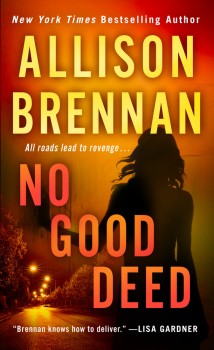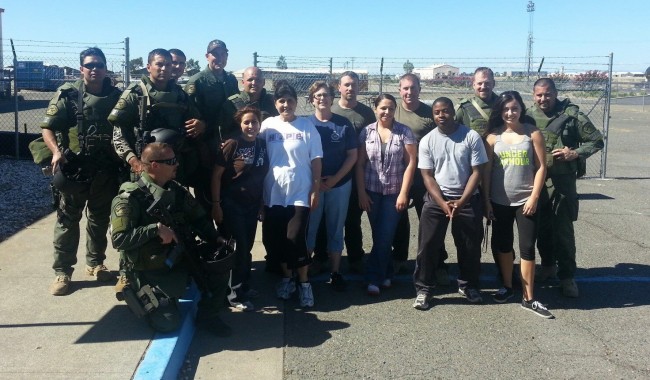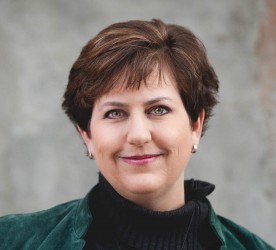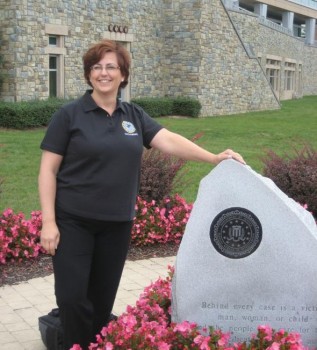No Good Deed by Allison Brennan
Uncovering the Motivations of Complex Characters
 By Josie Brown
By Josie Brown
Nuanced in your writing voice. Detailed in your research. Prolific in your output. In this era of publishing, these are the key ingredients for a successful thriller author.
Allison Brennan is proof of that.
Come April 2016—just 10 years since her debut as an author—she will have published 30 books and 12 novellas. Besides racking up numerous book award nominations—and being awarded finalist status 12 times—Allison is a Daphne du Maurier award winner. She has also won a Romantic Times Reviewer’s Choice award, and was a finalist for “Best Paperback Original” with International Thriller Writers.
In her latest novel, NO GOOD DEED, Allison’s protagonist, FBI agent Lucy Kincaid, is up against an escaped convict—former DEA agent Nicole Rollins—with a vendetta against her. Yet, after a daring escape, Nicole does one very stupid thing: She sticks around in order to play cat-and-mouse with Lucy. At the same time, Nicole has a more pragmatic motivator not to flee: embezzlement of tens of millions of dollars.
All great stuff. And all the more reason to get Allison to open up on what it takes to stay at the top of her game, one book at a time.
Talk about good cop gone bad! Allison, how did you come up with this dual plot dilemma? And for that matter, did the yin and yang of Nicole’s motivations make your writing process for this story more difficult or more fun, considering the number of obstacles it puts in Nicole’s way, and of course Lucy’s too?
One of my favorite parts of writing is uncovering the motivation of my characters. For Lucy it’s easy—NO GOOD DEED is her tenth book. I know why she does what she does, and for me the fun part is giving her more complex and difficult decisions to make—and putting her in unfamiliar situations. But a villain is only as compelling as his or her motivation.
While Nicole does have a vendetta against Lucy and those who (in Dead Heat) uncovered her illegal activities and put her in prison, there is no doubt in my mind that if it wasn’t about the money, she would have left the country. Nicole was stuck—if she didn’t get the money that the FBI seized, she wouldn’t be able to stay in hiding for long. It was a risk she had to take because her long-term survival depended on having the resources to elude authorities. I didn’t quite figure that out at first … but as soon as I got into her head, it all came together.
To ensure your readers gnaw their nails to the quick, you then throw another female antagonist into the mix: Elise Hansen, an underage sociopath. How did the idea for this enthralling character come about?
Elise was introduced in the beginning of Best Laid Plans, the book immediately prior to NO GOOD DEED. In the very first chapter she killed a man. This started a cascade of actions and reactions by both the FBI and the bad guys.
Elise is a catalyst of sorts, but also a true sociopath—she will do or say anything to get what she wants. She has no fear, she’s incapable of being scared, even when she should be. She lies, manipulates, threatens—she’ll use sex as a tool or weapon, cry at the drop of a pin, kill if necessary. Even though she’s only 16, Elise is chilling—at least I hope she is! But she’s also still a child in some ways—petty, curious, petulant, and impulsive.
In this book, the family dynamic comes at you in all directions. Did it start as the kernel of the idea for this book? What research did you do for your procedural authenticity into children’s social services and the psychology of family dysfunction?

Brennan with FBI Citizens Academy members and FBI SWAT during training at McClellan Air Force Base, Sacramento, 2013.
I didn’t realize that family was the core theme until I was halfway done and I saw the parallels between Nicole, Lucy, and Sean and how they all view family loyalty. Everything Nicole does—everything she is—is because of her family. She will do anything and everything to protect her family, even when they screw things up.
Likewise, Lucy and Sean will do anything to protect each other, and protect their respective families. When Kane goes missing in Mexico, the last thing Sean wants to do is leave Lucy with Nicole on the loose and targeting FBI agents … but Sean is the only person who can track Kane. Kane is his brother. He can’t let him die. That bond is strong, and I hope in NO GOOD DEED I’ve shown why.
With Lucy, her family is in law enforcement. They’re the good guys, Nicole’s family is the bad guys. But when the shit hits the fan, Lucy’s family is there for Lucy, and Nicole’s family is there for Nicole. I liked how that all worked out. I didn’t even plan it that way, but when I saw it develop, I edited with the theme in mind.
As far as research … well, I read a lot of true crime, and I absorb what I read. The details I look up as I go, such as how they handle court hearings or plea details and things like that. I have a very normal(ish) family, but a vivid imagination!
Considering Lucy’s personal history—the near-fatal attack by an online predator—one would think her choice for profession would be unbearable. Instead, she grows, emotionally, in each subsequent book. What is your technique for moving her through her healing process?
The key was that I started Lucy’s series seven years after she was kidnapped, raped, and nearly killed. She had many years to go to college, study, grow up, deal with a lot of the emotional and physical issues that plagued her. She still had some things to resolve internally, but that’s where Sean came in—she didn’t think she could love someone. She has many barriers—even now she has a few left—but Sean has patience and he’s stubborn.
At shooting range during FBI Citizens Academy alumni event, 2011
So far, Lucy’s series has 10 books, with two more on the way. I didn’t want each story to be a rehash of her trauma. She has to grow over the course of the series or the series becomes stagnant. So I structurally designed the series in sort of trilogies – the first three books are about Lucy falling in love and being able to accept that she’s worthy of Sean’s love. They are also about her growing up and facing new challenges, such as in the second book when she is denied acceptance into the FBI Academy and has to rethink everything she thinks she wants and needs. Each mystery is distinct and takes Lucy and Sean, respectively, from Washington to New York City then to the Adirondacks.
The second three books are her Quantico stories. She and Sean are in a good place in their relationship, but it’s still new; she has some internal battles to fight, namely how to control her panic attacks and learning how to stand up for herself. She gains confidence through the situations she faces, and accepts the consequences of her actions when her choices defy the rules. These are also the stories of Sean’s past and how he has to address issues that could come back to hurt him or Lucy. The stories are set in Washington, Quantico and New York City.
Then, starting with Dead Heat, Lucy is a full FBI agent and I moved the series to San Antonio, Texas. First, so that new readers could start at a logical place and understand what’s going on without reading the earlier books, and second because it’s a clear delineation between Lucy the aspiring FBI agent to Lucy the rookie FBI agent. Emotionally, she is ready to be a cop, she and Sean Rogan, a technology security advisor, are in a good place in their relationship, and the past is in the past. Yes, it sometimes becomes an issue – Lucy can’t have children because of what happened to her when she was 18, and that bothers her on a deep emotional level. When her sister Carina gives birth at the end of Best Laid Plans, that pain comes out, and Lucy and Sean had to address it so they could move forward.
I think in any series, the characters need to grow over time. I hope that readers can pick up the series at any point and enjoy the story—each mystery is solved and the suspense elements are all there—but for continuing readers, I hope they enjoy the emotional development of Sean and Lucy over time. Lucy is definitely not the same person she was in Love Me to Death, but she still has the same core inner strength that defines her.
Lucy and Sean are now engaged. This couple has been able to keep it together through a lot of turmoil, to say the least. What is the key for keeping their relationship fresh, despite the challenges they face, both professionally and personally?
Right now, Sean and Lucy are in a great place. As the series continues (I have at least two more books after NO GOOD DEED) I hope that any conflict—internal or external, with her job or with Sean—is organic to Lucy’s character and to the suspense. For her professionally, she’s going to have to regain the trust of her colleagues. She violated protocol several times over the last three books. It doesn’t matter that it was for the right reasons, she has to deal with the fall out. Sean has little tolerance for authority or the rules that Lucy is forced to work under, and that has caused some friction—but may well cause more as the series progresses.
In addition, as Sean digs roots in San Antonio, his own private activities may conflict with Lucy’s responsibilities. I don’t know exactly what’s going to happen, which is the most exciting part of writing a series. As for their personal relationship, I gave a hint at the end of NO GOOD DEED as to what Sean and Lucy’s next big obstacle is. Sean kept a secret from Lucy, primarily to protect her, and at the end of the book, Lucy makes Sean promise to never keep her in the dark, that not knowing is worse. Well, Sean should never made a promise he doesn’t know he can keep. I’ll leave it at that!
Diligent research is always the cornerstone of your process, and it shows in NO GOOD DEED. Did you run across any procedural methods that were a total surprise, or gave you a “THAT’S IT” moment?
Not really—at least not in this book. I used some of my knowledge about how the FBI operates to make this book as authentic as possible—for example, Waco is one of the FBI embarrassments, so when one of my agents goes to a remote ranch in Los Angeles County with a search warrant she is distinctly worried that there may be a bloody stand-off. I like to put in those authentic observations from my characters, hopefully to make the reader feel like she’s right there in the story.
One fun story, not really related to procedure: I know next to nothing about planes. I wrote a scene where Sean is rescuing Kane in Mexico and flying off in a small plane while being fired upon by drug runners. I learned that our mutual good friend, Deborah Coonts, is a pilot and flight instructor, so I sent her the scene for her advice. She pointed out a half dozen things I’d gotten totally wrong – so wrong to the point that any pilot would have tossed the book across the room. She helped me fix them 🙂 The scene turned out even better than I’d originally had it!
It’s not always easy weaving such complex plot threads into a satisfying conclusion for readers. What is your process for plotting?
Easy–I don’t plot.
Ha! I’d say that makes you a rare bird—but I know better. I think only half the authors I know actually plot out their books. And yet, since you began writing a decade ago—both romantic thriller trilogies and straight thriller series—you’ve published four, sometimes five projects a year—either full novels or novellas. How do you make the decision to start, or end, a series?
At the beginning, starting and ending was easy. I wrote four romantic thriller trilogies. I used the same world, but they were written as trilogies, with common characters and themes. My supernatural thriller series … that died a painful death when my publisher cancelled it. I wrote and self-published the third (and last) book even though I’d planned more, but I’ll likely not continue the series because of lack of interest. For Lucy, NO GOOD DEED is book Number 10, and I’m contracted for two more. I have more ideas, and I will probably write 15-20 books for Lucy and Sean. But I also know me, and I don’t want to get bored writing the same characters, so when St. Martin’s Press let me write a second series, I created a character very different from Lucy.
The third Maxine Revere book comes out in April. Being able to write a Max book, then a Lucy book, keeps both series fresh and interesting to me, and therefore I hope fresh and interesting for my readers. Because Max and Lucy are so different, I don’t think I’ll get bored. I’ll end a series either when my publisher doesn’t want anymore, I’m bored with the characters, or I don’t have any more ideas for the characters. Or if I come up with something different I want to write … then I might retire or put a series on hold so I can do something new.
I think every dictionary has your photo beside the definition of “prolific.” What is your process for keeping your focus on the task at hand—writing a good book—while at the same time managing a family with five very active kids?
Three books and two novellas. I don’t consider a novella a full book—they’re shorter, they usually aren’t as complex and more linear in the storyline because you don’t have the space to layer in sub-plots. So, we’ll call it 3.67 books 🙂
I write every day. The kids go to school, I write. The kids sleep, I write. I would like to say I write 10-12 hours a day, but truly, I probably only get in a solid 4-6 writing hours. I’m the worst procrastinator. Facebook, reading, television, baseball, oh look, there’s a squirrel …
I think the important thing is to be consistent. I write every day. Sometimes just editing what I wrote the day before, but I believe you have to show up every day because this is my job. So I get up, get the kids off to school, sit down at the computer, answer email and fart around on Facebook and Twitter, then start in on my writing day by 10 or 10:30 … I take a long break when the kids get home at 3:30 because we have sports (or drama or shopping or fill-in-the-blank) and then after dinner and television and homework I’ll often sit back down at my desk for a couple hours, especially if I’m close to a deadline.
Some days I write a thousand words … other days I write five thousand words. Once, I wrote 21,000 words in 15 hours of straight writing … but that’s rare. Very rare. I don’t care as much about my daily word count as about the quality of the scene or scenes I wrote. But the truth? A book is born when the author puts in the time: the time to write, the time to re-write, the time to re-write yet again. So I put in the time.
What is your process for keeping readers glued to the page?
Process? I don’t think there is one. I figure if I’m engaged, my readers will be engaged. If I’m bored, my readers will be bored. So if I re-read something I wrote and it’s boring or slow or I cringe, I either delete or edit. Likely every 100,000 word book was actually 500,000 words of writing, deleting, rewriting, revising, editing …
What are your next releases?
After NO GOOD DEED, I have an ebook novella I co-wrote with Laura Griffin in our Moreno & Hart Mystery series (Frosted) in December; and then the third book in that series (Lost and Found) in January.
What can readers expect from you in 2016?
The mass market edition of Compulsion (Max Revere #2) will be out in February, and then Max Revere #3, Poisonous, comes out in April 2016!
I’m particularly excited about Poisonous. I set out to do something specific, and I wasn’t sure I could pull it off. Not so much the plot, but bringing in a couple unique–different– characters. It also tackles the timely issue of cyberbullying. I just finished my final revisions and am very happy with the way the story turned out.
Then in the fall of 2016 Lucy Kincaid #11 will be out, followed quickly by Lucy #12. (Right now they’re scheduled for November 2016 and February 2017.)
And just as importantly to you, what will you do in your (I laugh as I write this) “down” time?
My life is all about writing and my kids. So my down time is spending it with my kids – I have two in college, so I try to talk to them at least once or twice a week. My 12-year-old daughter plays softball and soccer, my sons play football and wrestle, and all that takes time – practices, games, etc.
I’m also a television addict. I watch a lot of TV, and have been thrilled that over the last decade television has gotten so much better … often better than movies. My older son and I went through a Walking Dead marathon over the summer and we’re now binge-watching Breaking Bad. I watch Bones, Rizzoli & Isles, and Castle with my daughter; Arrow, Supernatural, Grimm, and Flash with my boys, and we all enjoy the new iZombie. For me, television is relaxing, and it’s a great way to decompress with the kids after we all get our work done.
*****
 Allison Brennan is the New York Times and USA Today bestselling and award winning author of two dozen romantic thrillers and mysteries, and numerous short stories. A former consultant in the California State Legislature, Allison lives in northern California with her husband, five kids, and assorted pets. She’s either writing, reading, playing video games, or attending her kids sporting events. Allison writes two series, the Lucy Kincaid/Sean Rogan romantic thrillers and the Maxine Revere mysteries.
Allison Brennan is the New York Times and USA Today bestselling and award winning author of two dozen romantic thrillers and mysteries, and numerous short stories. A former consultant in the California State Legislature, Allison lives in northern California with her husband, five kids, and assorted pets. She’s either writing, reading, playing video games, or attending her kids sporting events. Allison writes two series, the Lucy Kincaid/Sean Rogan romantic thrillers and the Maxine Revere mysteries.
To learn more about Allison, please visit her website.
Photography credit: Brittan Dodd
- Up Close: Jane Smiley - November 30, 2022
- Up Close: Lisa Barr - February 28, 2022
- Up Close: Kaira Rouda - December 31, 2021



